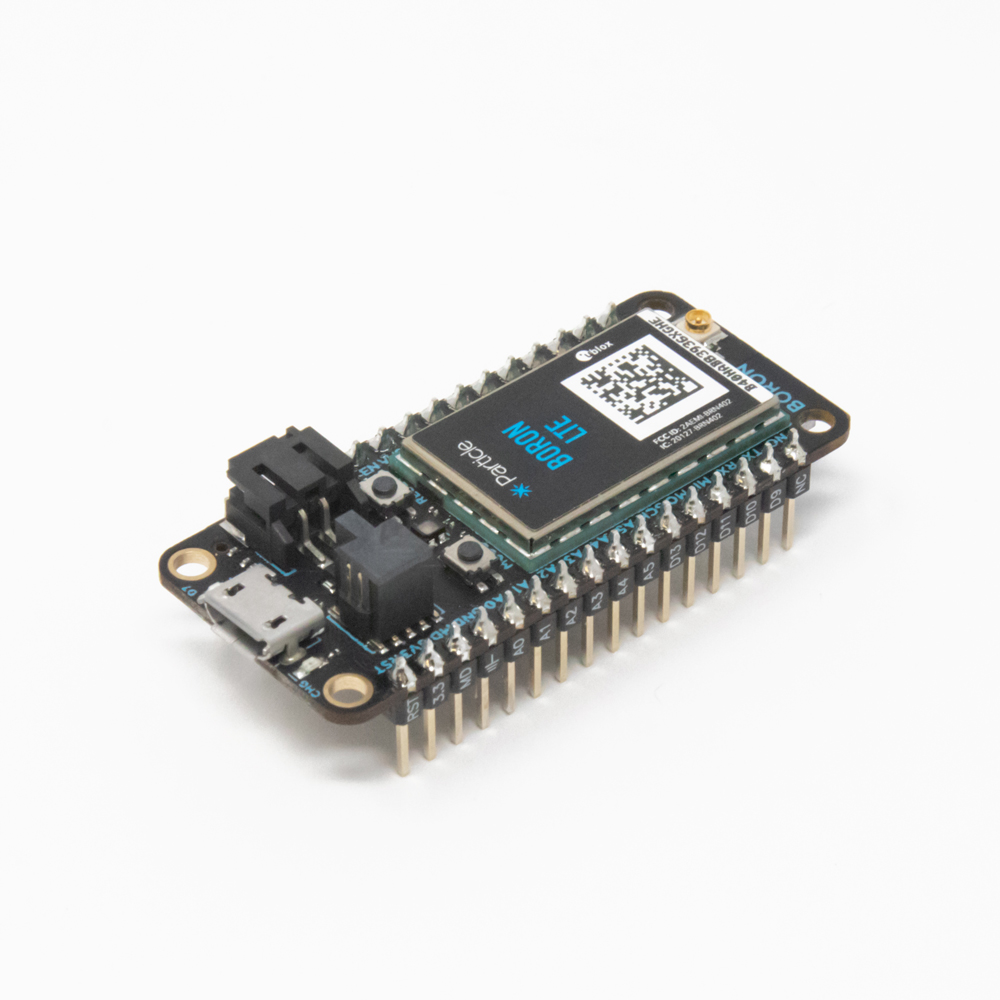Hardware overview
Finding the right Particle hardware for your project
Off-the-shelf complete
Particle gateway devices contain a cellular communication module in an enclosure with the required antennas and certification. IP67-rated waterproof connectors makes it easy to add external sensors and devices that communicate over protocols such as CAN bus, serial, and I2C.
Tracker One
If you want an off-the-shelf device can requires little or no hardware design, the Tracker One is a complete system with a waterproof IP67-rated enclosure. In includes cellular connectivity, GNSS (GPS) and Wi-Fi geolocation, and motion detection.
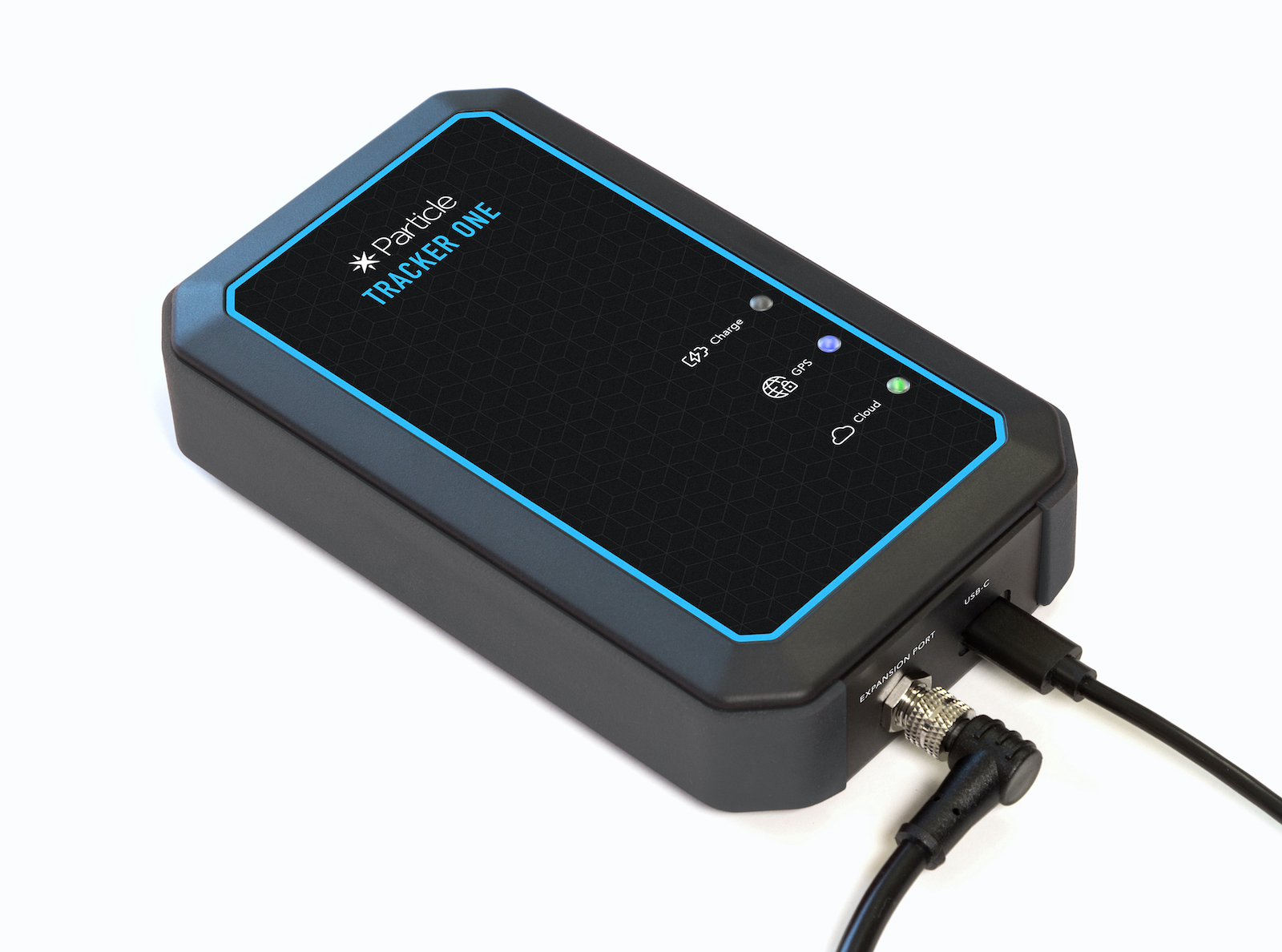
| SKU | Description | Region | Lifecycle |
|---|---|---|---|
| ONE404MEA | Tracker One LTE M1 (NorAm, EtherSIM), [x1] | NORAM | GA |
| ONE404MTY | Tracker One LTE M1 (NorAm, EtherSIM), Bulk [x40] | NORAM | GA |
| ONE523MEA | Tracker One LTE CAT1/3G/2G (Europe), [x1] | EMEAA | GA |
| ONE523MTY | Tracker One CAT1/3G/2G (Europe), Bulk [x40] | EMEAA | GA |
| ONE524MEA | Tracker One LTE CAT1/3G/2G (Europe, EtherSIM), [x1] | EMEAA | GA |
| ONE524MTY | Tracker One CAT1/3G/2G (Europe, EtherSIM), Bulk [x40] | EMEAA | GA |
ONE524: Selected countries in Europe, Middle East, Africa, and Asia, including Australia and New Zealand.
See the cellular carrier list.
The Tracker One is fully assembled and sealed; all you need to do is plug it in to wake it from shipping mode and you can immediately begin using it with no programming or assembly necessary!
Included inside the fully assembled, sealed enclosure:
- Built-in Particle SIM card (free for use up to certain limits, no credit card required).
- 2000 mAh LiPo battery.
- Cellular antenna.
- Wi-Fi antenna (for geolocation only, not for connectivity).
- BLE antenna.
- GNSS (GPS) antenna.
- NFC tag antenna.
- Power by USB-C or an external power supply.
Monitor One
The Monitor One has the same cellular and processor module (Tracker SoM), but is enclosed in a heavy duty waterproof enclosure that is large enough to contain expansion cards.
| SKU | Description | Region | Modem | EtherSIM | Lifecycle | Replacement |
|---|---|---|---|---|---|---|
| MON404E01C01KIT | Monitor One LTE CAT-M1 (NorAm, EtherSIM), Particle Transparent Enclosure, IO Card, Developer Edition [x1] | NORAM | BG96-MC | ✓ | GA | |
| MON524E01C01KIT | Monitor One LTE CAT-1/3G/2G (Europe, EtherSIM), Particle Transparent Enclosure, IO Card, Developer Edition [x1] | EMEAA | EG91-EX | ✓ | GA | |
| MON404E02C01KIT | Monitor One LTE CAT-M1 (NorAm, EtherSIM), Particle Blue Enclosure, IO Card, Developer Edition [x1] | NORAM | BG96-MC | ✓ | In development |
MON524: Selected countries in Europe, Middle East, Africa, and Asia, including Australia and New Zealand. See the cellular carrier list.
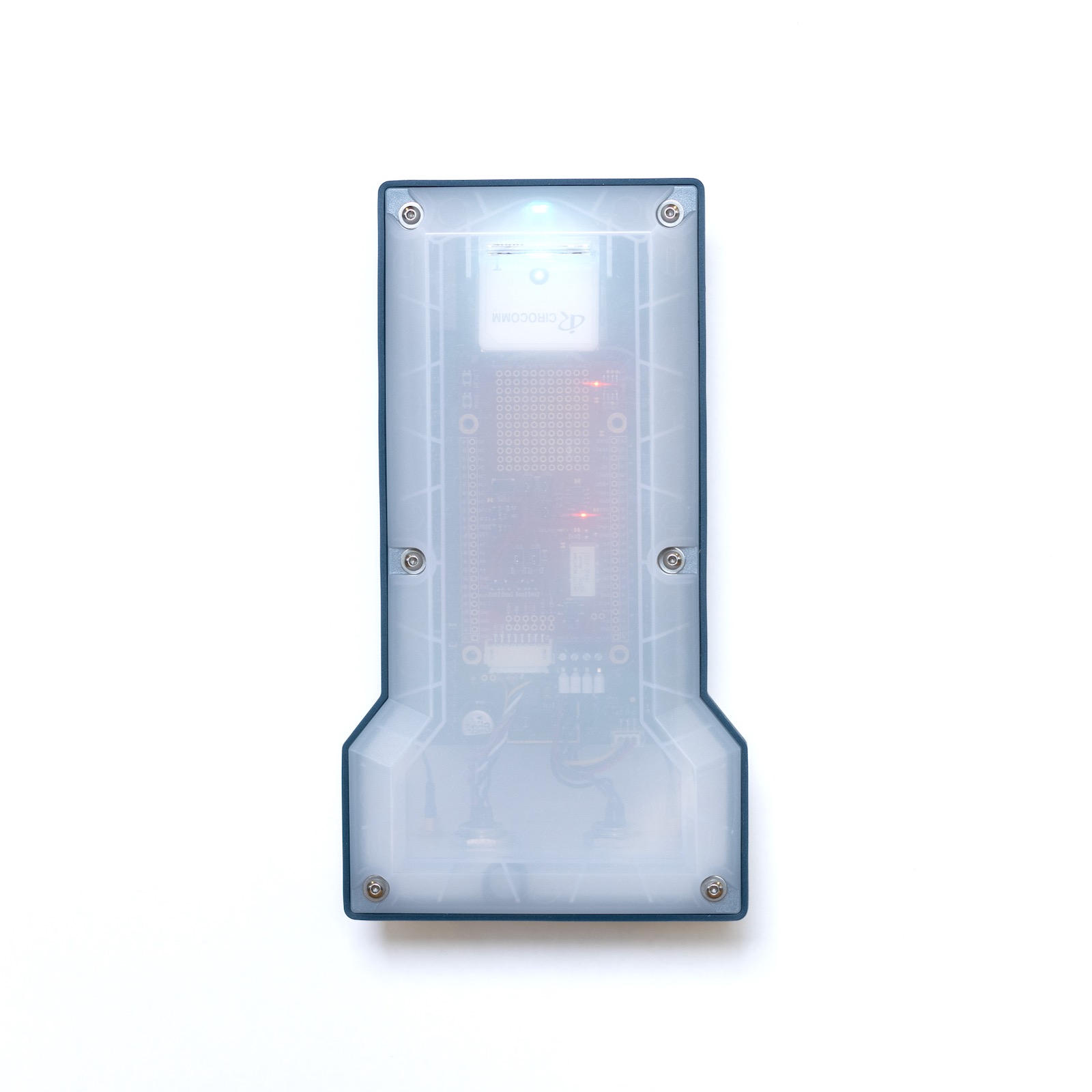
Production devices
Production devices integrate with a custom base board to provide the functionality you need for your product.
M-SoM
The M-SoM multi-radio module is designed to fit in an M.2 NGFF socket on your custom base board.
- Can use cellular or Wi-Fi (2.4 GHz or 5 GHz) for the cloud connection
- Realtek RTL8722DM MCU (BLE and Wi-Fi)
- Cellular modem
- M404: Quectel BG95-M5 LTE Cat M1/2G (Global)
- M524: Quectel EG91-EX LTE Cat 1 with 2G/3G fallback (EMEAA)
- M635: Quectel BG95-M5 LTE Cat M1/2G (Global with satellite)
Additionally, through your base board you can add additional functionality including network interfaces in addition to the built-in cellular and Wi-Fi:
| Interface | Required module |
|---|---|
| Ethermet | WizNET W5500 |
| LoRaWAN | Quectel KG200Z |
For prototyping with the M-SoM module, see Muon, below.
| SKU | Description | Region | Modem | EtherSIM | Lifecycle | Replacement |
|---|---|---|---|---|---|---|
| M404MEA | M-Series LTE-M/2G (Global, EtherSIM), [x1] | Global | BG95-M5 | ✓ | GA | |
| M404MTY | M-Series LTE-M/2G (Global, EtherSIM), Tray [x50] | Global | BG95-M5 | ✓ | GA | |
| M524MEA | M-Series LTE CAT1/3G/2G (Europe, EtherSIM), [x1] | EMEAA | EG91-EX | ✓ | GA | |
| M524MTY | M-Series LTE CAT1/3G/2G (Europe, EtherSIM), Tray [x50] | EMEAA | EG91-EX | ✓ | GA | |
| M635EMEA | M-Series LTE M1/2G/Satellite Kit (Global, EtherSIM), [x1] | Global | BG95-S5 | In development | ||
| M635MEA | M-Series LTE M1/2G/Satellite Kit (Global, EtherSIM), [x1] | Global | BG95-S5 | ✓ | In development |
The M404 is fully supported in the United States, Canada, and Mexico. It is in beta testing in other locations.
See the carrier list for country compatibility information.
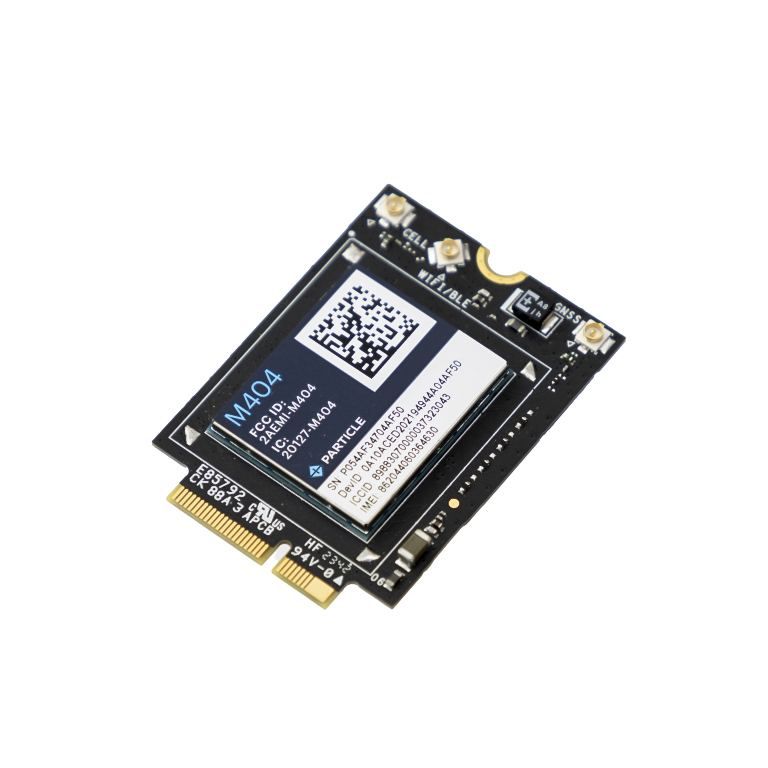
B-SoM
The B-SoM includes only cellular (not Wi-Fi, satellite, or LoRaWAN). It uses the same M.2 NGFF socket as the M-SoM, though there are some minor differences because of the use of differnet MCUs (Realtek RTL8722 in M-SoM and Nordic nRF52840 in B-SoM).
| SKU | Description | Region | Lifecycle |
|---|---|---|---|
| B404XMEA | B-Series LTE-M (NorAm, EtherSIM), [x1] | NORAM | GA |
| B404XMTY | B-Series LTE-M (NorAm, EtherSIM), Tray [x50] | NORAM | GA |
| B504EMEA | B-Series LTE CAT-1/3G (NorAm, EtherSIM+), [x1] | Americas | GA |
| B504EMTY | B-Series LTE CAT-1/3G (NorAm, EtherSIM+), [x50] | NORAM | GA |
| B524MEA | B-Series LTE CAT-1/3G/2G (Europe, EtherSIM) [x1] | EMEAA | GA |
| B524MTY | B-Series LTE CAT-1/3G/2G (Europe, EtherSIM), Tray [x50] | EMEAA | GA |
| M2EVAL | Particle M.2 SoM Evaluation Board [x1] | Global | GA |
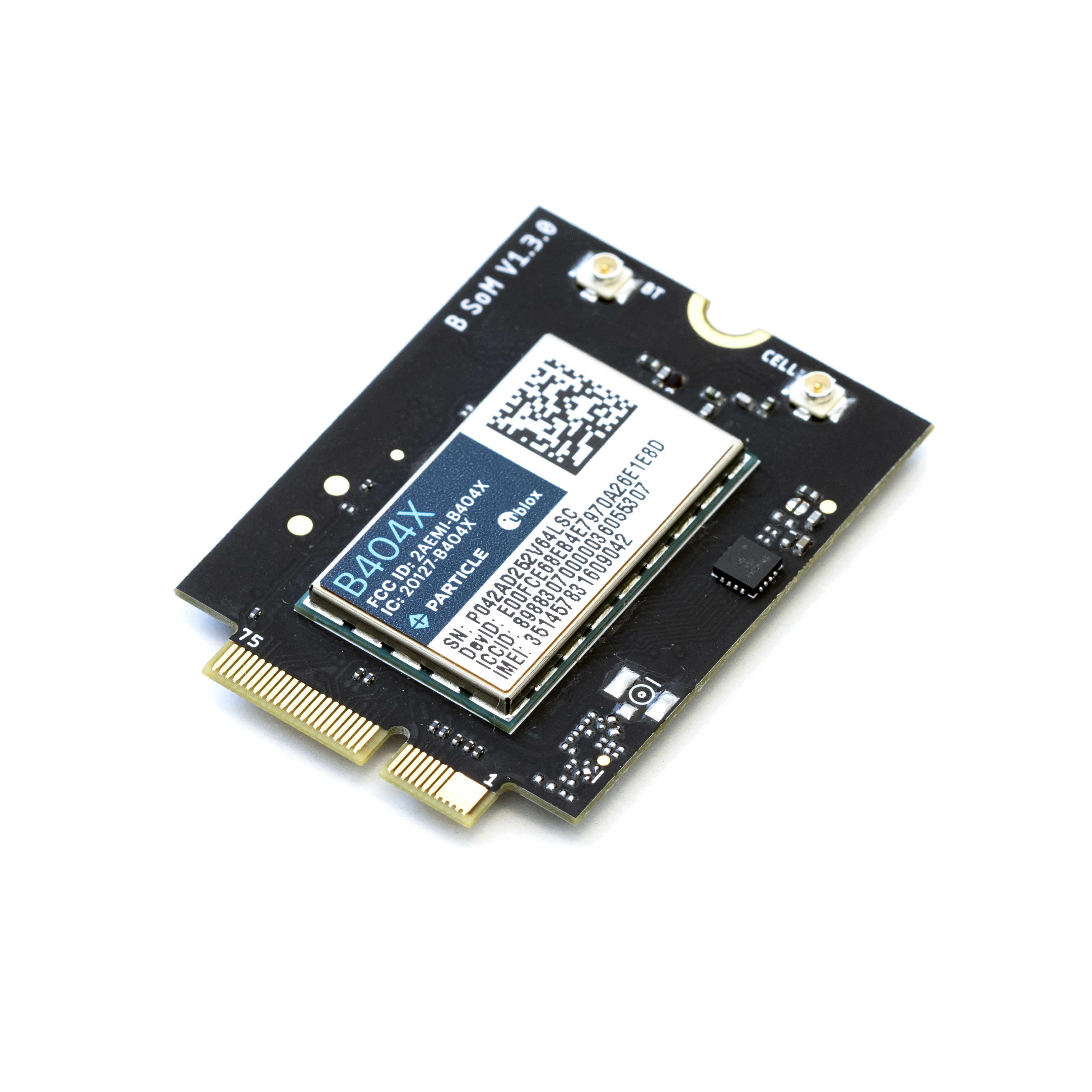
P2
The P2 is a Wi-Fi only module using the Realtek RTL8721DM module. The MCU is very similar to the M-SoM MCU, with the same fast speed and large amount of flash and RAM, making it useful for low-cost devices performing computationally intensive edge computing tasks, including running machine learning models.
The P2 must be reflow soldered to a base board. For prototyping, see the Photon 2, below.
P2 modules are available from store.particle.io as cut tape in quantities of 10 each.
| SKU | Description | Region | Lifecycle | Replacement |
|---|---|---|---|---|
| P2MOD10 | P2 Wi-Fi Module, Cut tape [x10] | Global | GA | |
| P2REEL | P2 Wi-Fi Module, Reel [x600] | Global | GA |
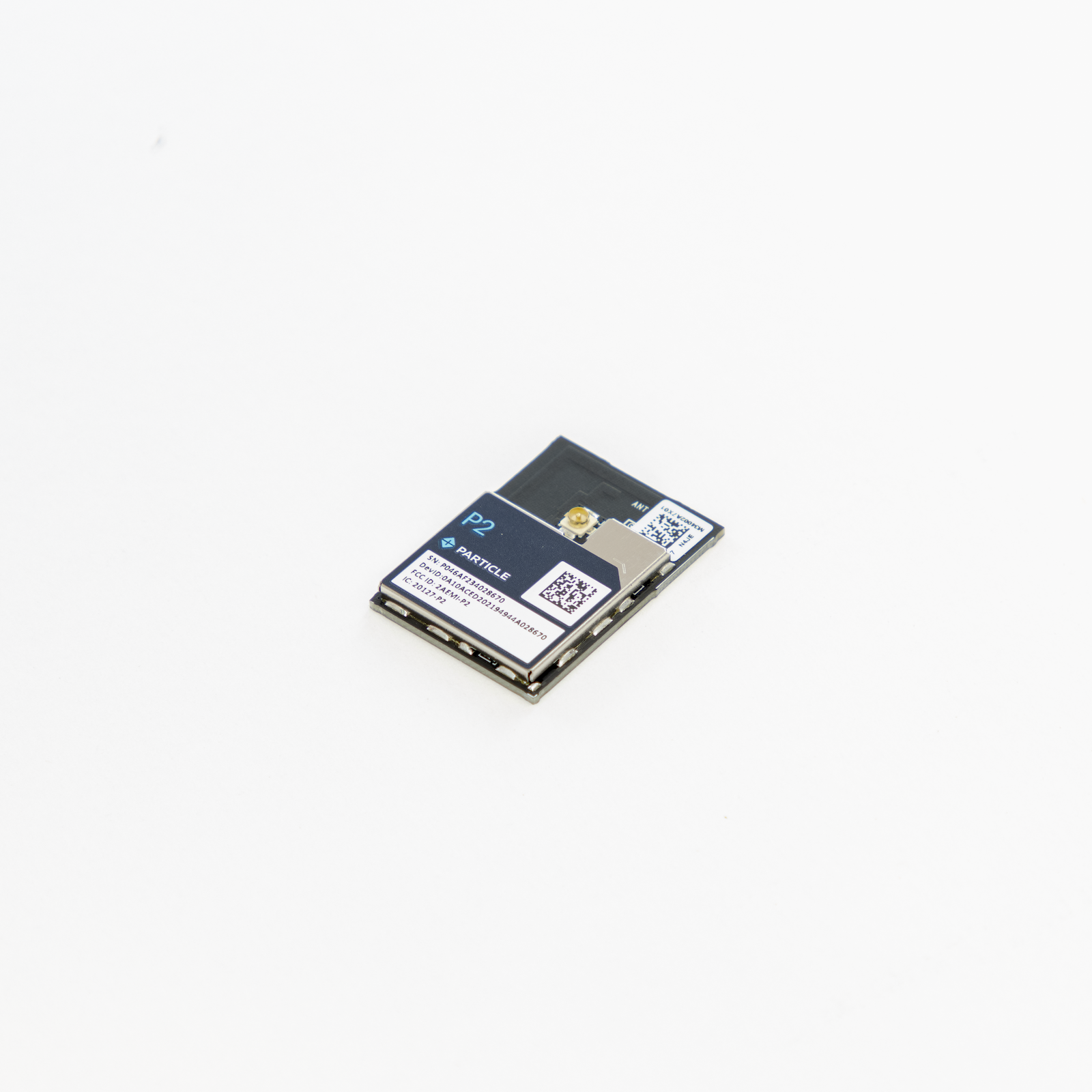
Tracker SoM
The Asset Tracker SoM is a castellated SoM designed to be reflow soldered to your own base board. If you need a more custom design that is possible with the Tracker One or Monitor One, you can directly use the same module contained in these devices.
Prototyping devices
Muon
The Muon contains an M-SoM module in a M.2 socket and a carrier board with an expansion connector, along with additional peripherals, including:
- LoRaWAN module (Quectel KG200Z, 862 – 928 MHz)
- Expansion connector
- Temperature sensor (TMP112A)
- Configuration EEPROM (24CW640T)
- Real-time clock and watchdog chip (AM1805)
- Reset and mode buttons
- RGB status LED
- Power input options
- USB-C
- VIN (6-12 VDC)
- LiPo battery with temperature sensor (3-pin JST-PH)

The Muon contains a Particle M-SoM that the following functional units:
- M.2 SoM form-factor, like the B-Series SoM
- Can use cellular or Wi-Fi (2.4 GHz or 5 GHz) for the cloud connection
- Realtek RTL8722DM MCU (BLE and Wi-Fi)
- Cellular modem
- M404: Quectel BG95-M5 LTE Cat M1/2G (Global)
- M524: Quectel EG91-EX LTE Cat 1 with 2G/3G fallback (EMEAA)
- M635: Quectel BG95-M5 LTE Cat M1/2G (Global with satellite)
The M404 is fully supported in the United States, Canada, and Mexico. It is in beta testing in other locations. See the carrier list for country compatibility information.
The Muon can be used in a number of ways:
- As a prototyping device, as-is, or using Dupont wires to connect to a solderless breadboard.
- Expanded using Sparkfun Qwiic and Adafruit STEMMA QT plug-and-play I2C sensors and peripherals.
- Design your own expansion card, either as a prototype or for production.
- Incorporate the features of the Muon into your own design based on the M-SoM.
| SKU | Description | Region | Modem | EtherSIM | Lifecycle | Replacement |
|---|---|---|---|---|---|---|
| MUON404 | Muon LTE-M/2G Dev Board (Global, EtherSIM), [x1] | Global | BG95-M5 | ✓ | GA | |
| MUON404EA | Muon LTE-M/2G Kit (Global, EtherSIM), [x1] | Global | BG95-M5 | ✓ | GA | |
| MUON524 | Muon LTE CAT1/3G/2G Dev Board (Europe, EtherSIM), [x1] | Global | EG91-EX | ✓ | GA | |
| MUON524EA | Muon LTE CAT1/3G/2G Kit (Europe, EtherSIM), [x1] | Global | EG91-EX | ✓ | GA | |
| MUON635 | Muon LTE M1/2G/Satellite Dev Board (Global, EtherSIM), [x1] | Global | BG95-S5 | ✓ | In development | |
| MUON635EA | Muon LTE M1/2G/Satellite Kit (Global, EtherSIM), [x1] | Global | BG95-S5 | ✓ | In development |
See the cellular carrier list for supported countries.
Photon 2
The Photon 2 is a prototyping module for Wi-Fi networks based on the P2 module. It is an Adafruit Feather form-factor with pins on the bottom that are ideal for use in a solderless breadboard.
Since it contains a P2 module, you can also use it as a development kit for creating your own product based on a P2 module, as software is fully compatible between the two devices.
| SKU | Description | Region | Lifecycle | Replacement |
|---|---|---|---|---|
| PHN2KIT | Photon 2, Kit [x1] | Global | GA | |
| PHN2MEA | Photon 2 [x1] | Global | GA | |
| PHN2MTY | Photon 2, Tray [x50] | Global | GA | |
| PHN2EDGEKIT | Edge ML Kit for Photon 2 (Photon 2 included) | Global | Deprecated |
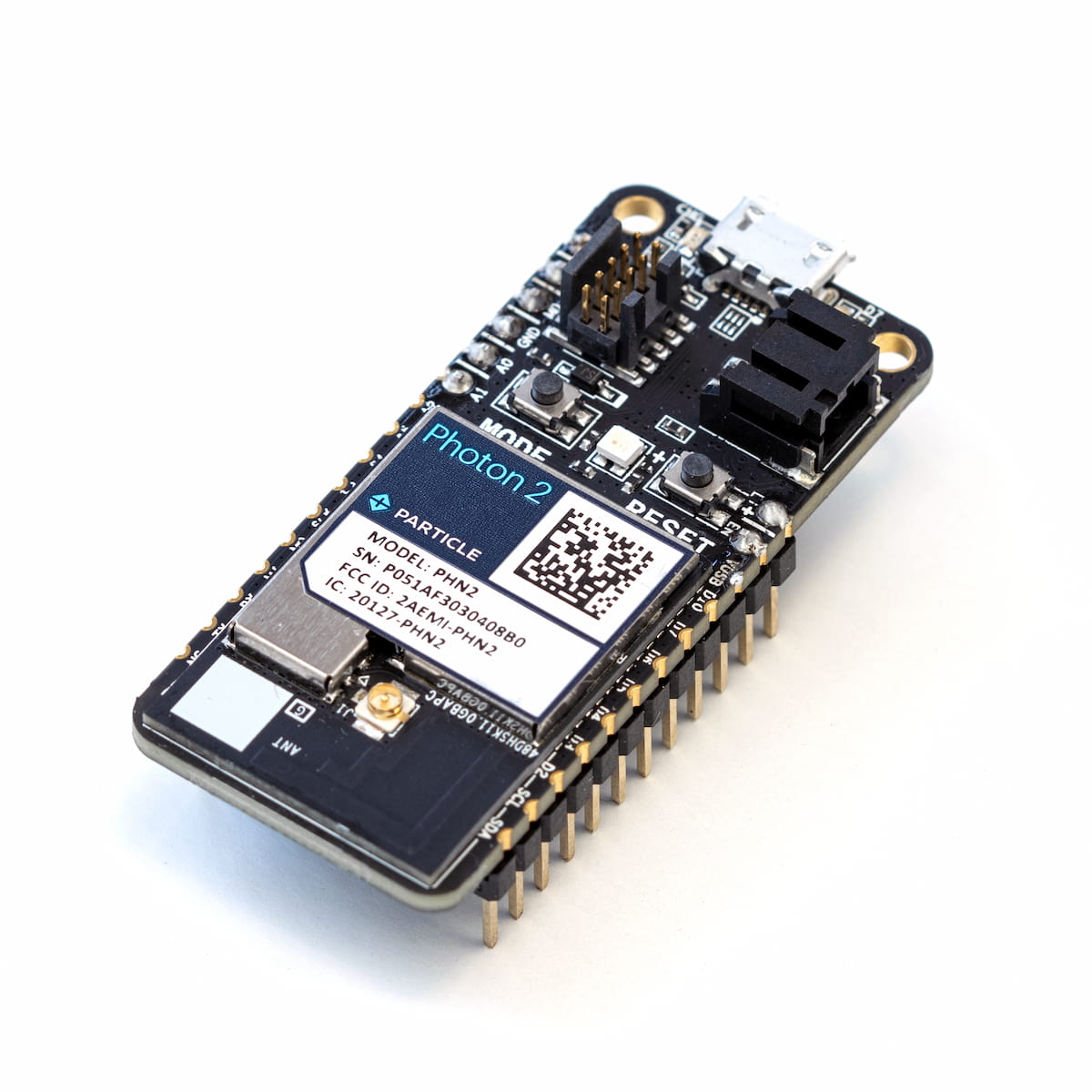
Boron
The Boron is a prototyping module for cellular networks. It is an Adafruit Feather form-factor with pins on the bottom that are ideal for use in a solderless breadboard.
There is no Boron version for EMEAA (Europe, Middle East, Africa, and Asia), as the LTE Cat 1 with 2G/3G fallback cellular modem on the B524 would not physically fit in the Feather form-factor.
| SKU | Description | Region | Battery Inc | Cell Ant Inc | Lifecycle |
|---|---|---|---|---|---|
| BRN404X | Boron LTE CAT-M1 (NorAm), [x1] | NORAM | ✓ | GA | |
| BRN404XKIT | Boron LTE CAT-M1 (NorAm, EtherSIM), Starter Kit [x1] | NORAM | ✓ | GA | |
| BRN404XTRAY50 | Boron LTE CAT-M1 (NorAm), Tray [x50] | NORAM | GA |
